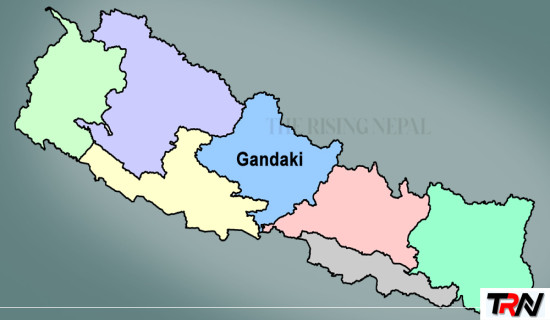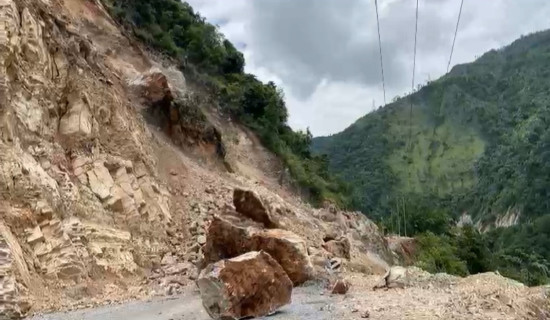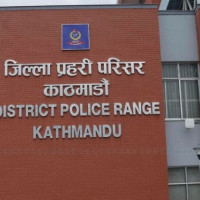- Saturday, 2 August 2025
Discovery of ancient weapons in Bardibas sparks archaeological discussion
By Ajay Shah,Mahottari, May 29: An archaeological study has commenced at a site in Bardibas, Mahottari, where a 12,000-year-old weapon factory was discovered.
According to Dipesh Kafle, member secretary of the Culture and Tourism Promotion Committee of Bardibas Municipality, a team of archaeologists from the Department of Archaeology began a study in the Patu and Rai Mandal areas of Bardibas Municipality-3 on Saturday.
The discovery of stone tools used by ancient humans in the area has led the municipality to initiate research to further highlight the site’s significance. The municipality has coordinated with a team led by archaeologist Bhaskar Gyawali and Prof. Dr. Majit Hazarika from Assam, India, to promote archaeological tourism and preserve historical and archaeological heritage.
German researcher Gudrun Corvinus studied human civilisation across various parts of the Tarai in the 1980s and, in 2007, published a book titled Prehistoric Cultures in Nepal, in which she identified the Patu and Rai Mandal region of Mahottari as a site of Mesolithic-era weapon production. In Volume 1, page 239 of her book, Corvinus has mentioned that human civilisation in the area near the Ratu River dates back 10,000 years.
She noted that thousands of Mesolithic weapons were found buried in red soil, suggesting that this might be one of the oldest known human civilisations in the region.
The Mesolithic period spans roughly from 12,000 to 10,000 years ago, followed by the Neolithic period from around 10,000 to 6,000 years ago. Corvinus concluded that this site reflects a civilisation from the Mesolithic period, approximately 10,000 years ago.
Why Corvinus chose to study this particular area, Rai Mandal and Patu, remains something of a mystery. However, her discovery of a Mesolithic-era weapon factory has since captured public curiosity and interest.
In her book, she indicated that Patu, located along the Ratu River, was densely populated during the Mesolithic era, 10,000 to 12,000 years ago.
Archaeologist Bhaskar Gyawali stated that stone tools from the Mesolithic period are being collected and studied in the Patu, Ratu, and Rai Mandal areas of Bardibas-3.
He noted, “The region and the tools discovered here will be observed and researched for the next 10 days. Many researchers have already published reports and books on this area, and some of the stone tools are exhibited by the Department of Archaeology. Hence, a more detailed study has been initiated.”
Although the present-day village of Patu was settled only in the 1960s, locals were astounded to learn from Corvinus’ research that their land may have been home to a civilisation 12,000 years ago.
“While walking through the forest, we used to come across peculiar stone tools like axes and sharp blades. After hearing through the media that Patu was home to a 12,000-year-old civilisation, we started searching for those kinds of tools again,” said local Ramesh Paudel. “This land has great potential for archaeological tourism.”
The Bardibas Chamber of Commerce and Industry has also shown its interest in this mysterious archaeological site.
Led by Chairman Bishnu Khadka, the Chamber submitted a report to the then Tourism Minister Sudan Kirati to promote the site as a tourist destination. As a result, nearly 4.6 million rupees have been allocated by the federal and provincial governments.
The Mesolithic-era weapon factory, used to make stone weapons, is believed to have been not just a production site but also a population hub. Corvinus found thousands of such weapons buried in red soil.
“It seems this place could become one of the world's leading research centres,” said Chairman Khadka. “We visited the Department of Archaeology to observe some of the tools discovered by Corvinus.”
The media coverage has drawn attention of archaeologists from across the country, many of whom have expressed strong interest in Patu’s Mesolithic-era weapon factory.
“This place has the potential to become a globally significant archaeological tourism site,” said geologist Prakash Darnal. “I’ve heard that both federal and provincial governments have allocated budget. A master plan is needed.”
Corvinus’ findings are currently housed at the National Museum. Her book notes that tens or even hundreds of thousands of artefacts were buried between 30 and 50 centimetres beneath the red soil.
The government’s enthusiasm to protect these relics and develop the area as a historic tourist destination has encouraged other archaeologists as well.
“We have uncovered much glorious history about Patu,” said archaeologist Somnath Sapkota. “The local government must show strong interest. Corvinus not only discovered a Mesolithic-era capital of weaponry here but also suggested that it may have been the capital of serpents and holds secrets related to the great earthquake of 1218 BS.”
The earthquake of 1218 BS is considered the first recorded devastating earthquake in Nepal’s history. According to experts, it occurred on a Monday, Ashadh Shukla Tritiya, with a magnitude of around 7.7 on the Richter scale. King Abhaya Malla reportedly died in this earthquake, which affected nearly one-third of the Kathmandu Valley's population.
Historians say the earthquake caused the plains and low hills (Chure range) to rise even higher.
One such uplifted area is believed to be the upper region of Patu, including the Rai Mandal area, which now stands as a testimony to the earthquake that jolted Nepal 863 years ago.
According to geologist Somnath Sapkota, many PhD students have conducted research in Patu and published their findings in academic journals.
Bardibas Mayor Prahlad Kumar Kshetri stated that the local government has already begun work on managing and promoting the site. He expressed confidence that the Rai Mandal and surrounding regions could become the foundation for Bardibas Municipality’s prosperity.
To reach Rai Mandal from the flat plains of Bardibas, one must climb about 7 kilometres uphill. There lie the scenic Bhimdanda and Soli Ghopte hills, which appear to gaze endlessly across the flatlands of Madhes.
Standing about 362 metres above sea level, these hills are not only the jewels of the Terai but also the pillars of Bardibas’s future growth. Waiting to be recognised and developed, they are as stunning as they are full of promise.
















